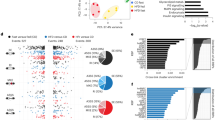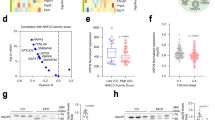Abstract
Bakground/Objectives:
Intense drug discovery efforts in the metabolic field highlight the need for novel strategies for the treatment of obesity. Alternative splicing (AS) and/or polyadenylation enable the LMNA gene to express distinct protein isoforms that exert opposing effects on energy metabolism and lifespan. Here we aimed to use the splicing factor SRSF1 that contribute to the production of these different isoforms as a target to uncover new anti-obesity drug.
Subjects/Methods:
Small molecules modulating SR protein activity and splicing were tested for their abilities to interact with SRSF1 and to modulate LMNA (AS). Using an LMNA luciferase reporter we selected molecules that were tested in diet-induced obese (DIO) mice. Transcriptomic analyses were performed in the white adipose tissues from untreated and treated DIO mice and mice fed a chow diet.
Results:
We identified a small molecule that specifically interacted with the RS domain of SRSF1. ABX300 abolished DIO in mice, leading to restoration of adipose tissue homeostasis. In contrast, ABX300 had no effect on mice fed a standard chow diet. A global transcriptomic analysis revealed similar profiles of white adipose tissue from DIO mice treated with ABX300 and from untreated mice fed a chow diet. Mice treated with ABX300 exhibited an increase in O2 consumption and a switch in fuel preference toward lipids.
Conclusions:
Targeting SRSF1 with ABX300 compensates for changes in RNA biogenesis induced by fat accumulation and consequently represents a novel unexplored approach for the treatment of obesity.
This is a preview of subscription content, access via your institution
Access options
Subscribe to this journal
Receive 12 print issues and online access
$259.00 per year
only $21.58 per issue
Buy this article
- Purchase on Springer Link
- Instant access to full article PDF
Prices may be subject to local taxes which are calculated during checkout






Similar content being viewed by others
References
Van Gaal LF, Mertens IL, De Block CE . Mechanisms linking obesity with cardiovascular disease. Nature 2006; 444: 875–880.
Ford ES, Giles WH, Dietz WH . Prevalence of the metabolic syndrome among US adults: findings from the third National Health and Nutrition Examination Survey. JAMA 2002; 287: 356–359.
Saltiel AR . New therapeutic approaches for the treatment of obesity. Sci Transl Med 2016; 8: 323rv2.
Spiegelman BM, Heinrich R . Biological control through regulated transcriptional coactivators. Cell 2004; 119: 157–167.
Guan X-M, Chen H, Dobbelaar PH, Dong Y, Fong TM, Gagen K et al. Regulation of energy homeostasis by bombesin receptor subtype-3: selective receptor agonists for the treatment of obesity. Cell Metab 2010; 11: 101–112.
Tseng Y-H, Cypess AM, Kahn CR . Cellular bioenergetics as a target for obesity therapy. Nat Rev Drug Discov 2010; 9: 465–482.
Lopez-Mejia IC, De Toledo M, Chavey C, Lapasset L, Cavelier P, Lopez-Herrera C et al. Antagonistic functions of LMNA isoforms in energy expenditure and lifespan. EMBO Rep 2014; 15: 529–539.
Worman HJ, Bonne G . ‘Laminopathies’: a wide spectrum of human diseases. Exp Cell Res 2007; 313: 2121–2133.
Wilson KL, Zastrow MS, Lee KK . Lamins and disease: insights into nuclear infrastructure. Cell 2001; 104: 647–650.
Navarro CL, Cau P, Lévy N . Molecular bases of progeroid syndromes. Hum Mol Genet 2006; 15 (Spec No 2): R151–R161.
Eriksson M, Brown WT, Gordon LB, Glynn MW, Singer J, Scott L et al. Recurrent de novo point mutations in lamin A cause Hutchinson-Gilford progeria syndrome. Nature 2003; 423: 293–298.
De Sandre-Giovannoli A, Bernard R, Cau P, Navarro C, Amiel J, Boccaccio I et al. Lamin a truncation in Hutchinson-Gilford progeria. Science 2003; 300: 2055.
Arai Y, Takayama M, Abe Y, Hirose N . Adipokines and aging. J Atheroscler Thromb 2011; 18: 545–550.
Lopez-Mejia IC, Vautrot V, De Toledo M, Behm-Ansmant I, Bourgeois CF, Navarro CL et al. A conserved splicing mechanism of the LMNA gene controls premature aging. Hum Mol Genet 2011; 20: 4540–4555.
Vautrot V, Aigueperse C, Oillo-Blanloeil F, Hupont S, Stévenin J, Branlant C et al. Enhanced SRSF5 protein expression reinforces Lamin A mRNA production in HeLa cells and fibroblasts of progeria patients. Hum Mutat 2016; 37: 280–291.
Tazi J, Bakkour N, Stamm S . Alternative splicing and disease. Biochim Biophys Acta 2009; 1792: 14–26.
Soret J, Bakkour N, Maire S, Durand S, Zekri L, Gabut M et al. Selective modification of alternative splicing by indole derivatives that target serine-arginine-rich protein splicing factors. Proc Natl Acad Sci USA 2005; 102: 8764–8769.
Bakkour N, Lin Y-L, Maire S, Ayadi L, Mahuteau-Betzer F, Nguyen CH et al. Small-molecule inhibition of HIV pre-mRNA splicing as a novel antiretroviral therapy to overcome drug resistance. PLoS Pathog 2007; 3: 1530–1539.
Campos N, Myburgh R, Garcel A, Vautrin A, Lapasset L, Nadal ES et al. Long lasting control of viral rebound with a new drug ABX464 targeting Rev-mediated viral RNA biogenesis. Retrovirology 2015; 12: 30.
Venables JP, Lapasset L, Gadea G, Fort P, Klinck R, Irimia M et al. MBNL1 and RBFOX2 cooperate to establish a splicing programme involved in pluripotent stem cell differentiation. Nat Commun 2013; 4: 2480.
Makeyev EV, Maniatis T . Multilevel regulation of gene expression by microRNAs. Science 2008; 319: 1789–1790.
McGregor RA, Choi MS . microRNAs in the regulation of adipogenesis and obesity. Curr Mol Med 2011; 11: 304–316.
Wu H, Sun S, Tu K, Gao Y, Xie B, Krainer AR et al. A splicing-independent function of SF2/ASF in microRNA processing. Mol Cell 2010; 38: 67–77.
Melamed Z, Levy A, Ashwal-Fluss R, Lev-Maor G, Mekahel K, Atias N et al. Alternative splicing regulates biogenesis of miRNAs located across exon-intron junctions. Mol Cell 2013; 50: 869–881.
Ortega FJ, Moreno-Navarrete JM, Pardo G, Sabater M, Hummel M, Ferrer A et al. MiRNA expression profile of human subcutaneous adipose and during adipocyte differentiation. PLoS One 2010; 5: e9022.
Lengacher S, Nehiri-Sitayeb T, Steiner N, Carneiro L, Favrod C, Preitner F et al. Resistance to diet-induced obesity and associated metabolic perturbations in haploinsufficient monocarboxylate transporter 1 mice. PLoS One 2013; 8: e82505.
Cáceres JF, Screaton GR, Krainer AR . A specific subset of SR proteins shuttles continuously between the nucleus and the cytoplasm. Genes Dev 1998; 12: 55–66.
Longman D, Johnstone IL, Cáceres JF . Functional characterization of SR and SR-related genes in Caenorhabditis elegans. EMBO J 2000; 19: 1625–1637.
Li H, Cheng Y, Wu W, Liu Y, Wei N, Feng X et al. SRSF10 regulates alternative splicing and is required for adipocyte differentiation. Mol Cell Biol 2014; 34: 2198–2207.
Jackson VM, Breen DM, Fortin J-P, Liou A, Kuzmiski JB, Loomis AK et al. Latest approaches for the treatment of obesity. Expert Opin Drug Discov 2015; 10: 825–839.
Oldendorf WH . Lipid solubility and drug penetration of the blood brain barrier. Proc Soc Exp Biol Med 1974; 147: 813–815.
Jung H-J, Coffinier C, Choe Y, Beigneux AP, Davies BSJ, Yang SH et al. Regulation of prelamin A but not lamin C by miR-9, a brain-specific microRNA. Proc Natl Acad Sci USA 2012; 109: E423–E431.
Nissan X, Blondel S, Navarro C, Maury Y, Denis C, Girard M et al. Unique preservation of neural cells in Hutchinson- Gilford progeria syndrome is due to the expression of the neural-specific miR-9 microRNA. Cell Rep 2012; 2: 1–9.
Tazi J, Durand S, Jeanteur P . The spliceosome: a novel multi-faceted target for therapy. Trends Biochem Sci 2005; 30: 469–478.
Bonnal S, Vigevani L, Valcárcel J . The spliceosome as a target of novel antitumour drugs. Nat Rev Drug Discov 2012; 11: 847–859.
Pandit S, Zhou Y, Shiue L, Coutinho-Mansfield G, Li H, Qiu J et al. Genome-wide analysis reveals SR protein cooperation and competition in regulated splicing. Mol Cell 2013; 50: 223–235.
Sanford JR, Coutinho P, Hackett JA, Wang X, Ranahan W, Cáceres JF . Identification of nuclear and cytoplasmic mRNA targets for the shuttling protein SF2/ASF. PLoS One 2008; 3: e3369.
Maslon MM, Heras SR, Bellora N, Eyras E, Cáceres JF . The translational landscape of the splicing factor SRSF1 and its role in mitosis. Elife 2014; 3: e02028.
Passetti F, Ferreira CG, Costa FF . The impact of microRNAs and alternative splicing in pharmacogenomics. Pharmacogenomics J 2009; 9: 1–13.
Fu X-D, Ares M . Context-dependent control of alternative splicing by RNA-binding proteins. Nat Rev Genet 2014; 15: 689–701.
Kwan T, Benovoy D, Dias C, Gurd S, Provencher C, Beaulieu P et al. Genome-wide analysis of transcript isoform variation in humans. Nat Genet 2008; 40: 225–231.
Heneghan HM, Miller N, Kerin MJ . Role of microRNAs in obesity and the metabolic syndrome. Obes Rev 2010; 11: 354–361.
Mori MA, Thomou T, Boucher J, Lee KY, Lallukka S, Kim JK et al. Altered miRNA processing disrupts brown/white adipocyte determination and associates with lipodystrophy. J Clin Invest 2014; 124: 3339–3351.
Ebert MS, Sharp PA . Roles for microRNAs in conferring robustness to biological processes. Cell 2012; 149: 515–524.
Mori M, Nakagami H, Rodriguez-Araujo G, Nimura K, Kaneda Y . Essential role for miR-196a in brown adipogenesis of white fat progenitor cells. PLoS Biol 2012; 10: e1001314.
Acknowledgements
We are grateful to the Montpellier-RIO imaging platform (Montpellier, France), the Histology Experimental Network of Montpellier and the IGMM animal facilities. We are grateful to Roscoe Klinck (Université de Sherbrooke), Pierre de la Grange (Genosplice) and Edouard Bertrand for the SRSF1-GFP HeLa cells. The screening reported in this paper was performed within the France-BioImaging national research infrastructure, at MRI, Montpellier. France-BioImaging is supported by the French National Research Agency through the ‘Investments for the Future’ program (ANR-10-INSB-04). We thank Julien Bellis, Sylvain de Rossi and Virginie Georget for conducting the screening and microscopy imaging. We thank also Laurie Gayte for her help during the in vivo experiments This work was supported by the collaborative laboratory ABIVAX, OSEO-ISI CaReNA grant and Fondation pour la Recherche Médicale (FRM) grant (Equipe FRM 2011—no. DEQ20111223745). JT is a senior member of the Institut Universitaire de France. CLH is an ESR fellow of the EU FP7 Marie Curie ITN RNPnet program (289007). ICLM was supported by a graduate fellowship from the Ministère Délégué à la Recherche et aux Technologies and CNRS.
Author information
Authors and Affiliations
Corresponding author
Ethics declarations
Competing interests
The authors declare no conflict of interest.
Additional information
Supplementary Information accompanies this paper on International Journal of Obesity website
Supplementary information
Rights and permissions
About this article
Cite this article
Santo, J., Lopez-Herrera, C., Apolit, C. et al. Pharmacological modulation of LMNA SRSF1-dependent splicing abrogates diet-induced obesity in mice. Int J Obes 41, 390–401 (2017). https://doi.org/10.1038/ijo.2016.220
Received:
Revised:
Accepted:
Published:
Issue Date:
DOI: https://doi.org/10.1038/ijo.2016.220
This article is cited by
-
RNA splicing is a key mediator of tumour cell plasticity and a therapeutic vulnerability in colorectal cancer
Nature Communications (2022)



